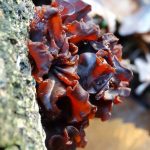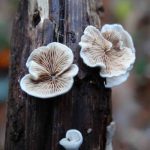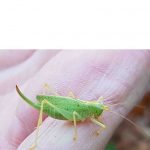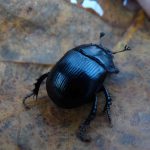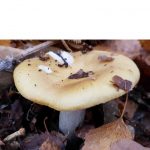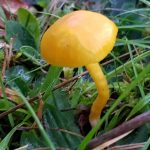Mike Waterman led a well-attended fungus identification walk at Pamber Forest on the afternoon of Saturday 17 November. It was a sunny but cool day and the autumn colours were close to their best. After a long, hot and dry summer and a mainly dry autumn, the fungus season had been slow to get going. Recent rain had encouraged more species to appear, but the numbers of ground-growing fungi still seemed to be depressed. The walk started out along the bridleway which runs southwards from the Impstone Road car park, before turning right through an open gateway into a grassy field. A small group of earthballs with distinct stem-like structures at their bases were identified as Scaly Earthball Scleroderma verrucosum. The field sloped down into a wood which was predominately of oak, but with a scattering of other species, including birch, Sweet Chestnut, willow and Scots Pine. Butter Caps Rhodocollybia butyracea, with two-toned brown, greasy caps, were found at the top of the wood. A stump was covered in pale grey Candlesnuff Fungus Xylaria hypoxylon, there were Birch Polypores Piptoporus betulinus on a fallen birch trunk and Turkeytail Trametes versicolor was found on a fallen branch. Bleeding Oak Crust Stereum gausapatum, which stains red when cut, was found on dead wood. It was suggested that tiny white blobs on a dead branch might be some sort of slime mould. A fallen log showed the characteristic turquoise-green staining of Green Elfcup Chlorociboria aeruginascens. One of the most unusual sightings of the afternoon was a dark brown, folded jelly fungus on a fallen tree trunk which was identified as Leafy Brain Tremella foliacea. Mike demonstrated that the stem of the Snapping Bonnet Mycena vitilis is brittle and makes an audible snapping noise when broken. A two-toned tufted fungus with a ring that was found on a dead branch was identified as Sheathed Woodtuft Kuehneromyces mutabilis. A stick had small creamy-white fan-like specimens of the Variable Oysterling Crepidotus variabilis, while the less common C. epibryus was found on an oak leaf. A fan-like gilled fungus on a dead oak branch was identified as Bitter Oysterling Panellus stipticus. There were a number of specimens of the orange Common Rustgill Gymnopilus penetrans under a big Scots Pine. Nearby was a pale yellow False Deathcap Amanita citrina. Mike commented that the dark brown Oak Curtain Crust Hymenochaete rubiginosa always looks old, even when it is actually still fresh. Apart from the fungi, a Goldcrest was singing in the canopy, a Dor Beetle and a bright green female Oak Bush-cricket were spotted and clumps of Hard Fern were noted. A clump of Sulphur Tuft Hypholoma fasciculare was found on a tree stump and small round specimens of Snowy Disco Lachnum virgineum were found on a dead branch. Walking back up to the top of the wood, a Blushing Bracket Daedaleopsis confragosa was seen on Goat Willow. Nearby was an Ochre Brittlegill Russula ochroleuca, whose identity was confirmed when its stem stained blue when a drop of resin in alcohol was applied. A drop of latex from the Mild Milkcap Lactarius subdulcis was put on white paper, where it did not change colour. A series of short irregular black lines on a Bracken stem were the Bracken Map Rhopographus filicinus. Back in the field above the wood, several specimens of the yellow Butter Waxcap Hygrocybe ceracea were found. The final sighting of the afternoon, in the wood by the car park, was a Parasol Mushroom Macrolepiota procera which was somewhat past its best. Mike showed how the ring could slide up and down the stem.
Pictures by Laurie Haseler
Pamber Forest, 17 November 2018
| Species | English name | Substrate | Ass.Organism |
| Amanita citrina var. citrina | False Deathcap | litter | Scots pine / Hazel |
| Annulohypoxylon multiforme | Birch Woodwart | fallen branch | Birch |
| Chondrostereum purpureum | Silverleaf Fungus | ||
| Clitocybe nebularis | Clouded Funnel | litter | Oak |
| Clitocybe unidentified | |||
| Coprinopsis atramentaria | Common Inkcap | stump | |
| Crepidotus epibryus | leaf | Oak | |
| Crepidotus variabilis | Variable Oysterling | fallen branch | |
| Daedaleopsis confragosa | Blushing Bracket | fallen branch | Goat willow |
| Gloeoporus taxicola? | fallen branch | ||
| Gymnopilus penetrans | Common Rustgill | fallen branch | Scots pine |
| Hygrocybe ceracea | Butter Waxcap | soil | Grass |
| Hymenochaete rubiginosa | Oak Curtain Crust | log | |
| Hypholoma fasciculare var. fasciculare | Sulphur Tuft | stump | |
| Kuehneromyces mutabilis | Sheathed Woodtuft | trunk fallen | |
| Lachnum virgineum | Snowy Disco | ||
| Lactarius subdulcis | Mild Milkcap | litter | |
| Macrolepiota procera var. procera | Parasol | ||
| Marasmiellus ramealis | Twig Parachute | stem | Bramble |
| Mycena vitilis | Snapping Bonnet | litter | |
| Panellus stipticus | Bitter Oysterling | fallen branch | |
| Piptoporus betulinus | Birch Polypore | trunk fallen | Birch |
| Postia subcaesia | Blueing Bracket | ||
| Pseudoclitocybe cyathiformis | Goblet | ||
| Rhodocollybia butyracea | Butter Cap | soil | |
| Rhopographus filicinus | Bracken Map | stem | Bracken |
| Russula ochroleuca | Ochre Brittlegill | ||
| Schizopora paradoxa | Split Porecrust | bark | |
| Scleroderma verrucosum | Scaly Earthball | soil | Oak |
| Stereum gausapatum | Bleeding Oak Crust | fallen branch | |
| Trametes versicolor | Turkeytail | fallen branch | Birch |
| Tremella foliacea | Leafy Brain | fallen branch | |
| Xylaria hypoxylon | Candlesnuff Fungus | stump |
List by Mike Waterman

